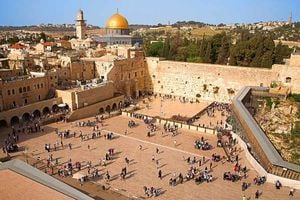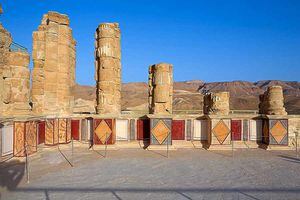Travel review: Jerusalem, Israel
It looms up on the horizon like a daunting death knell of long-forgotten youth.

Some try to embrace it, others push it under the doormat but it's always there, an undeniable statement of fact.
Time is passing, your bones are creaking and, yes, any minute now a Saga catalogue is dropping through your letterbox, Mr H.
You're hitting 50 son, whether you like it or not.
So what to do about travel plans, holidays and the like?
Well, as with most aspects of getting older (not old, just older you'll note), I'm defiantly raging against the dying of the light.
I'm also a realist, pragmatically setting out to visit places that have so far eluded my 48-year journey across 42 nation states.
So I'm targeting places I've always wanted to go and never got round to.
Top of the list: Jerusalem.
One-word summary: Wow.
When I was 40, I visited Rome for the first time and was blown away by its history and grandeur.
Nearly 50, I can't believe I've left it so long to visit this similar cradle of civilisation, dripping with history at every turn and packed with everything a visitor could wish for.

Fine hotels, good restaurants and sunshine, coupled with some of the world's most incredible historical sites make Israel – and Jerusalem in particular – an unmissable treat for travellers.
The rise of budget airlines mean that (despite Brexit) the country is well within reach of most holiday funds. The 2,500-mile flight to Tel Aviv takes around five hours with another hour or so on the road to Jerusalem, but the wait is well worth it, no matter who you fly with.
You'll soon find yourself snaking up the hills to Jerusalem, looking out over the Mount of Olives and diving deep into the heart of the ancient city that serves as a holy shrine for Christians, Jews and Muslims from all over the world.
Not surprising then that religious sites are the city's top attractions, and I defy anyone – irrespective of their beliefs – not to be moved following the Via Dolorosa.
This Latin 'Way of Sorrows' is firmly believed to be the path Jesus carried the cross on his way to crucifixion at nearby Calvary.
Punctuated with the Stations of the Cross at regular intervals, visitors can see the very places where Christ stumbled, was helped, paused and persisted to the place he eventually perished.
It is, quite simply, incredibly emotional and moving.
The cobbled streets seem virtually unchanged down the centuries and pilgrims pass by, singing hymns or praying out loud.
Eventually, the path leads to the church of the Holy Sepulchre, where the last five Stations of the Cross are found, along with the traditional sites of crucifixion and burial.
Here, be warned, the church is rarely less than crammed, with hour-long waits to catch a glimpse and touch the rock where, allegedly, Christ was crucified.
Nearby, the Room of the Last Supper is a quieter visit, but – while its origins are no doubt well-intentioned – its medieval architecture suggest it merely sprung up around the site several hundred years ago, not 2,000.
Back out in the open, the Western Wall of King Herod's huge temple is one of the most important places of worship in Judaisim.
Commonly known as the Wailing Wall, visitors often scribble prayers onto pieces of paper and push them into the cracks of the huge structure, which is just a relatively small section of the outer wall of Herod's huge building.

To get a sense of the size of the wall, take a trip underground to the Western Wall tunnels which reveal the full scale of the building; it is absolutely breathtaking. But not all history in this incredible city is ancient.
Allow at least half a day for the Vad Yashem World Holocaust Remembrance Centre, spread over 23 acres just a few minutes drive from the city centre and as emotional an experience as you're ever likely to witness.
The full horror of Nazi genoicide and persecution of the Jewish faith is laid bare and yet the centre still brings a sense of hope as well as remembrance.
The Hall of Names contains pages of testimony from those who suffered and those who survived and is a reason in itself to visit the city – it is one of THE great museums of remembrance in the world.
Nearby sits the Israel Museum with the delicate Dead Sea Scrolls on permanent display.
The 2,400-year-old parchment was discovered in a cave in 1946 and at first deemed so worthless that one Bedouin wanted to make shoes out of them.
Now they are revered as some of the most important religious documents on earth.
One other must-see tip is the nightly sound and light show at the Tower of David citadel, telling the story of the city over the past 2,000 years with dramatic scenes played out on the huge historic walls.
Elsewhere, as you would expect of a modern city, the hotels and restaurants are plentiful although the recent exchange rate fluctuations may make for an expensive trip if you're not careful. We enjoyed dinner at The Eucalyptus Restaurant (www.the-eucalyptus.com) where its high-quality King Solomon feast (around £50 per head) is served with friendliness and chat from helpful and informative staff.
But there is more to this part of the country than just this incredible holy city. A couple of hours away, through the West Bank is the Dead Sea – now evaporating at such an alarming rate that canals have been dug to keep water in areas where most hotels were built 40 years or so ago. Where once they sat beside the shoreline, the water has receded to such an extent that some hotels now bus guests to the water. No such problems with the perfectly-positioned Daniel hotel, one of several on an isolated stretch that not only sits close to the water's edge, but also makes use of the thick salty water for an outdoor pool.

Over the road, a once-in-a-lifetime dip in the Dead Sea is an absolute must, where it is impossible not only to sink – but also to swim.
Any attempt at a breast-stroke sees nothing more than the mineral-rich water bounce you back to the surface like a bobbing cork, a truly bizarre but memorable experience.
One often overlooked aspect of the water however, is its healing properties, with guides taking great pride in saying that many German and Scandinavian tourists with skin complaints visit just to soak in the water, which alleviates their conditions for months on end.
For somewhere to eat, the Bedouin experience at the nearby Taj Mahal offers something different while maintaining an authentic feel to its surroundings.
Not far from the Dead Sea lies yet another unmissable attraction, Herod's old palace at Masada, accessed (thankfully) by a cable car these days, it sits atop an unassailable rocky outcrop commanding an enviable defensive position overlooking the surrounding deserts.
However, nobody told the conquering Roman army it couldn't be taken, so when they arrived to take the fortress in 73AD they set about encircling it and planning their way in.
Over the next three years, they methodically built a 375-foot high assault ramp as the Jewish defenders watched from above. But on the eve of their final attack, the 900 or so Jewish defenders set all their buildings on fire and committed mass suicide, rather than fall into the Romans' hands. Dramatic stuff, so if you need to chill out after so much drama the Ein Gedi Nature Reserve offers peace, tranquillity and some of the best dates the land of milk and honey has to offer.
All-in-all an amazing experience and one I would thoroughly recommend to anyone wanting to visit somewhere off the beaten tourist track.
By Keith Harrison
